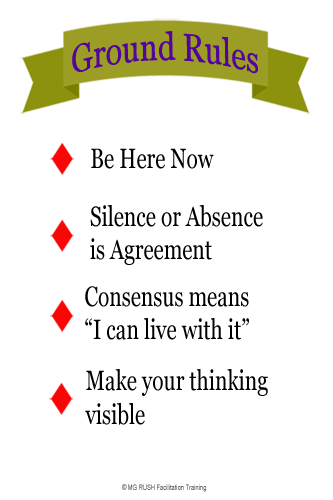Description
Use ground rules to help manage individual and group behavior during meetings and workshops.
You can lead meetings and discussions without ground rules, but did you ever leave an unstructured meeting with a headache? The term “discussion” is rooted similarly to the terms “percussion” and “concussion.” A little bit of structure will ensure that you get more done, fast.
Primary Ground Rules
Consider a few, select ground rules for every meeting, regardless of your situation. We consider the following four ground rules so important we use them in every meeting or workshop.
1. Be Here Now
First and foremost, speaks to the removal of distractions and getting participants to focus. Typically demands that electronic leashes be reined in—i.e., phones on stun mode, laptops down, be punctual after breaks, pay attention. The hardest thing to do with a group of smart people is to get them to focus on the same issue at the same time.
Your job is to remove distractions so that they can focus.
2. Consensus means “I can live with it”
We are NOT defining consensus as everyone’s favorite or top choice. Nor are we suggesting that our decisions will make everyone ‘happy.’ We are facilitating to a standard that everyone can professionally support. Participants agree they will NOT try to undermine the results after the meeting ends. If so, they are guilty of displaying a lack of integrity. We strive to build agreement that is robust enough to be considered valid by everyone. No one should lose any sleep over the results. Remember, however, it may not be their ‘favorite’ course of action.
3. Silence or absence implies consensus
This ground rule applies to structured, for-profit situations and NOT necessarily unstructured, political or social meetings. During our standard business meetings, participants have a duty to speak up. It remains the primary responsibility of the facilitator to protect all the meeting participants. It is NOT their job to reach down someone’s throat and pull it out of them. If participants have information to bear in a discussion, then it is their responsibility to share it. Participant involvement is their obligation, not simply their opportunity. Their silence speeds us up since we don’t have time to secure an audible from every participant on every point discussed in a meeting. Their silence indicates two positions that need to be stressed by the facilitator, namely:
- They will support it, and
- They will not lose any sleep over it.
If either is not true, shame on them—they are being paid to participate. If they cannot accept this responsibility, they should work somewhere else.
4. Make your thinking visible
People do not think causally. They think symptomatically. Two people eating from the same bowl of chili may argue over how “spicy” it is. Note, they seldom argue about verbs and nouns. Rather they argue about modifiers (eg, adjectives and adverbs). They subjectively argue about spiciness. To one, the chili is hot. To the other, it is not. They are both right. A great facilitator will get them to ‘objectify’ their discussion so that they both can agree that the chili is 1,400 Scoville Units. They don’t think Scoville Units, however, they think ‘hot”. As the facilitator, you must challenge them to make their thinking visible.
Read more about ground rules and secondary ground rules on our FAST Monthly Facilitation Blog




Reviews
There are no reviews yet.